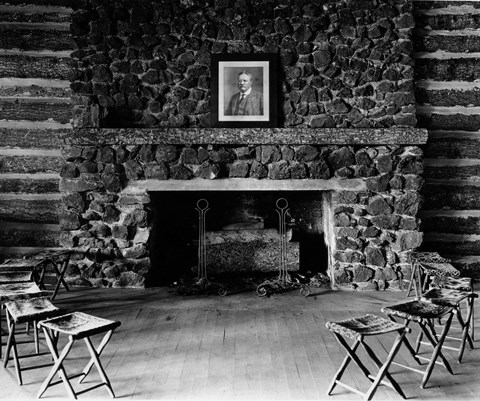
NPS / Haynes postcard The Roosevelt Lodge Historic District, which includes 130 buildings, was listed on the National Register of Historic Places in 1983, with a period of significance from 1906 to 1948. The accommodations are still rustic, with unpaved roads into and around the lodge and cabins. Although the Grand Loop Road can be seen from the corral, which is not part of the historic district, it is obscured from view of the lodge and most of the cabins by a stand of mature trees. The area has undergone intermittent expansion and changes as visitor use has changed and facilities have aged over the years. The architectural appearance of the original lodge is retained only in the interior and exterior of the front portion (the lounge and dining room); the other sections of the building have been modified. The interior has become congested with multiple activities, some of which were not part of the original building—a bar, vending machines, gift shop, and offices. In 2009, the National Park Service completed an environmental assessment for the Tower–Roosevelt area to set limits on the kind, location, and amount of development that will occur there in order to protect the area’s natural resources and preserve its historical character, including the rustic architecture of Roosevelt Lodge and the small cabins, the arrangement of the lodge and cabins around a grassy meadow, and the view from the lodge porch across the meadow to the distant mountains. The plan also called for pulling the parking lot away to improve views and reduce congestion near the lodge, which was accomplished in 2021. 
NPS / YELL 9554 Roosevelt Lodge, 1920 Indians, fur trappers, and explorers on the Bannock Trail camped in this area where a sagebrush meadow was encircled by Douglas fir, quaking aspen, and a mountain stream tumbled toward the Yellowstone River. President Chester Arthur camped here in 1883. In 1906, the Wylie Permanent Camping Company built a tent camp there that became known as “Camp Roosevelt,” though Theodore Roosevelt never camped there. The tents were replaced by a lodge and cabins in the 1920s, and the Lost Creek has shifted course, but people still enjoy staying at this scenic spot on the park’s northern range. For Dudes and Scientists Camp Roosevelt’s location provided an overnight stop for visitors traveling between Mammoth Hot Springs and Canyon. As at other Wylie camps, guests slept in striped tents with wood floors, gathered at a larger tent for communal meals and sing-alongs, and were transported around the park in the Wylie company’s vehicles. The successor to the Wylie company, the Yellowstone Park Camping Company, built the park’s first and smallest lodge at Camp Roosevelt in 1919. The lodges were built to accommodate the increasing number of visitors arriving in their own automobiles who wanted something more than a tent but less expensive and formal than the park’s hotels. During the 1920s and 1930s, the old hotels often stood empty while the new lodges overflowed with visitors. At Camp Roosevelt, the concessioners wanted to create the atmosphere of a dude ranch, and Superintendent Horace Albright described it as “a place visitors would like to stay indefinitely.” It did provide a base for fishing parties and saddle-horse trips, but it was also expected to serve as a field laboratory where teachers and their students could conduct research at minimum expense, a purpose that the first director of the National Park Service, Stephen Mather, was promoting for the parks. In what was a forerunner to the educational programs found in the parks today, the National Park Service hired H.S. Conard, a naturalist at Grinnell College, to present lectures and conduct daily field trips for Camp Roosevelt visitors and collect botanical specimens for the park museum. Scientists based at the hotel conducted studies on the park’s wildlife. From 1921 to 1923, the lodge was the headquarters for a boy’s summer camp run by Alvin Whitney of the New York State School of Forestry at Syracuse University. The Buildings The lodge, constructed of unpeeled logs and completed in 1920, was originally surrounded by 43 small log cabins, the first of which were completed in 1922. Over the years, the Roosevelt Lodge area became a repository for guest cabins brought from areas in the park where they were no longer wanted. By 1982, the corral had been moved farther from the cabins, of which there were now 110 of four main types. More Information |
Last updated: April 18, 2025
